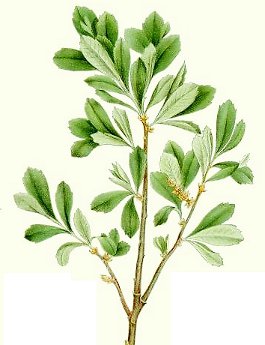 Myrica Gale
Myrica GaleBog Myrtle / Sweet Gale
Helpful for enhancing lucid dreaming and astral work generally, bog myrtle was a flavoring for a type of European beer known as gruit up until the introduction of hops. The other components of gruit were yarrow and marsh rosemary.* Some say this brew was the behind the Berserkers. In northern Europe, bog myrtle and yarrow have been ingredients in fermented drinks made from grain, honey, or fruit since the Iron Age, and it is still used in Scandinavia to make a liqueur called "snaps." This magic herb tastes both bitter and balsamic (rich like vanilla) and has a nice spicy aroma. The nut cones have the highest amount of the psychoactive properties of this herb. The whole plant has a wonderful resinous scent, and large stands can cast their fragrance for half a mile or so. The Potawatami Indians liked it enough to smudge with it. That makes sense of why this was a linen sachet and a strewing herb in Scotland; bugs hate the smell as much as we like it. This herb is dangerous for pregnant women. Despite the claims of some internet sources, bog myrtle and myrtle are two unrelated plants that grow in different parts of the world. This plant is also known as sweet gale and sweet willow (leaves look willow-like). It's aromatic, good for the skin, and protects against blood-sucking (Martial) insects, so despite the fact that its flowers are insignificant, consider it a Venus herb.
How to Grow Bog Myrtle
Barely cover seeds and cold stratify for six weeks at 41F/5C (or try Outdoor Treatment), although some of the seeds will germinate
without any cold stratification. Bog myrtle can grow in full sun to deep shade
but does not like heat. It prefers plenty of water and soil with peat
in it or near pines (acidic soil). Becomes
a shrub about 4-6ft/1.5-2m tall. Plants tend
to sucker after they've grown a few years. You can dig out a sucker
and plant that in a separate area to create more plants.
Cuttings will root best in a mixture of peat moss and sand. Plants can be
male or female and won't produce fertile seeds unless both are present. This
herb can fix nitrogen from the air, like a legume.
Some people are allergic to the pollen. It's hardy to zone 3 (-40F). In North
America, this plant is found throughout Canada, in the MidAtlantic,
New England, Great Lakes, and Northwest, and in the Allegheny Mountains,
but it is native to all of the northern hemisphere. General
growing info
Myrica gale
Bog Myrtle
70 seeds $4.50
Uses in Witchcraft & Magic:
Dreamwork
Astral Work
VenusHerb
© 2010-2024 Alchemy Works; No reproduction without permission